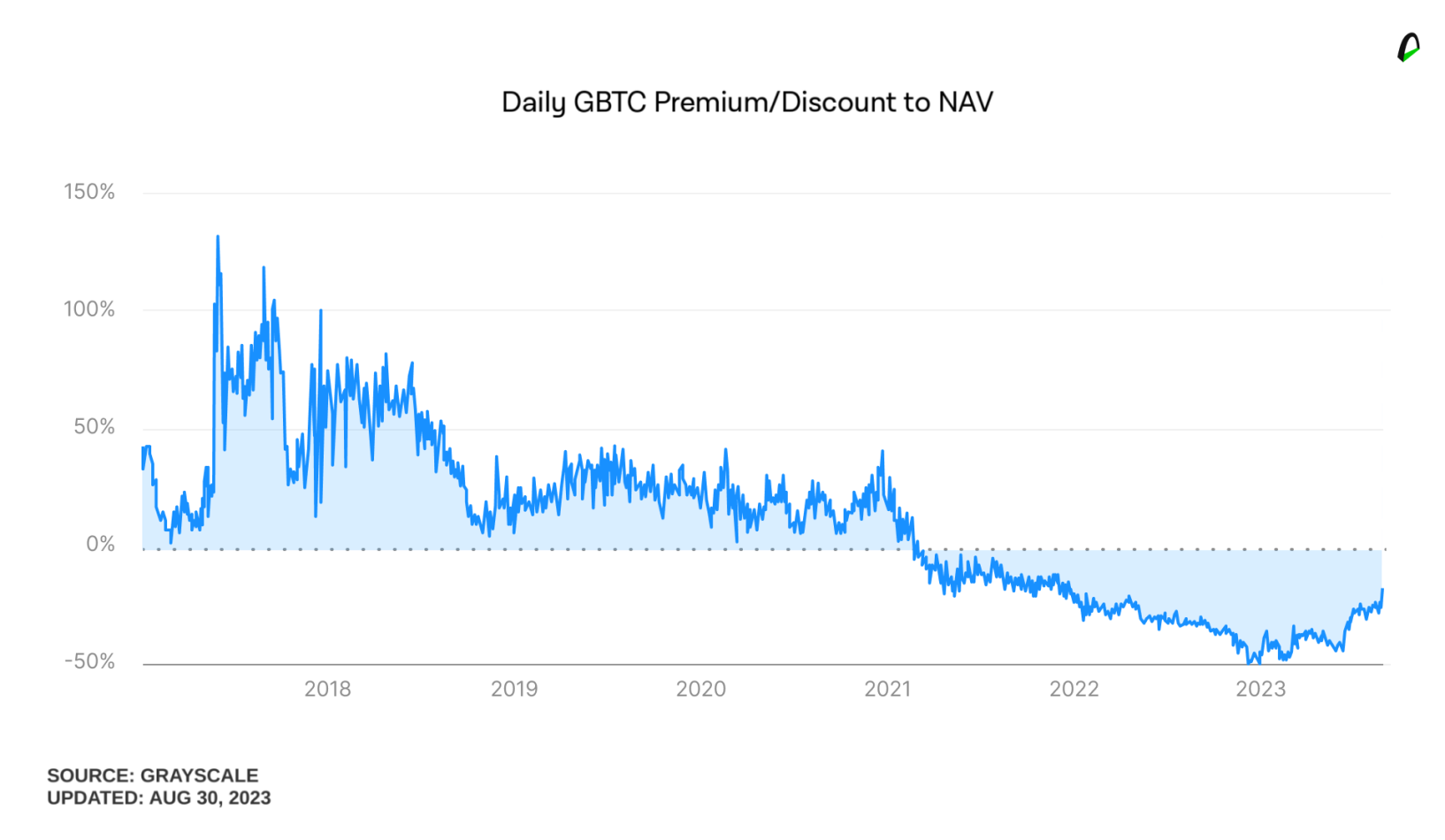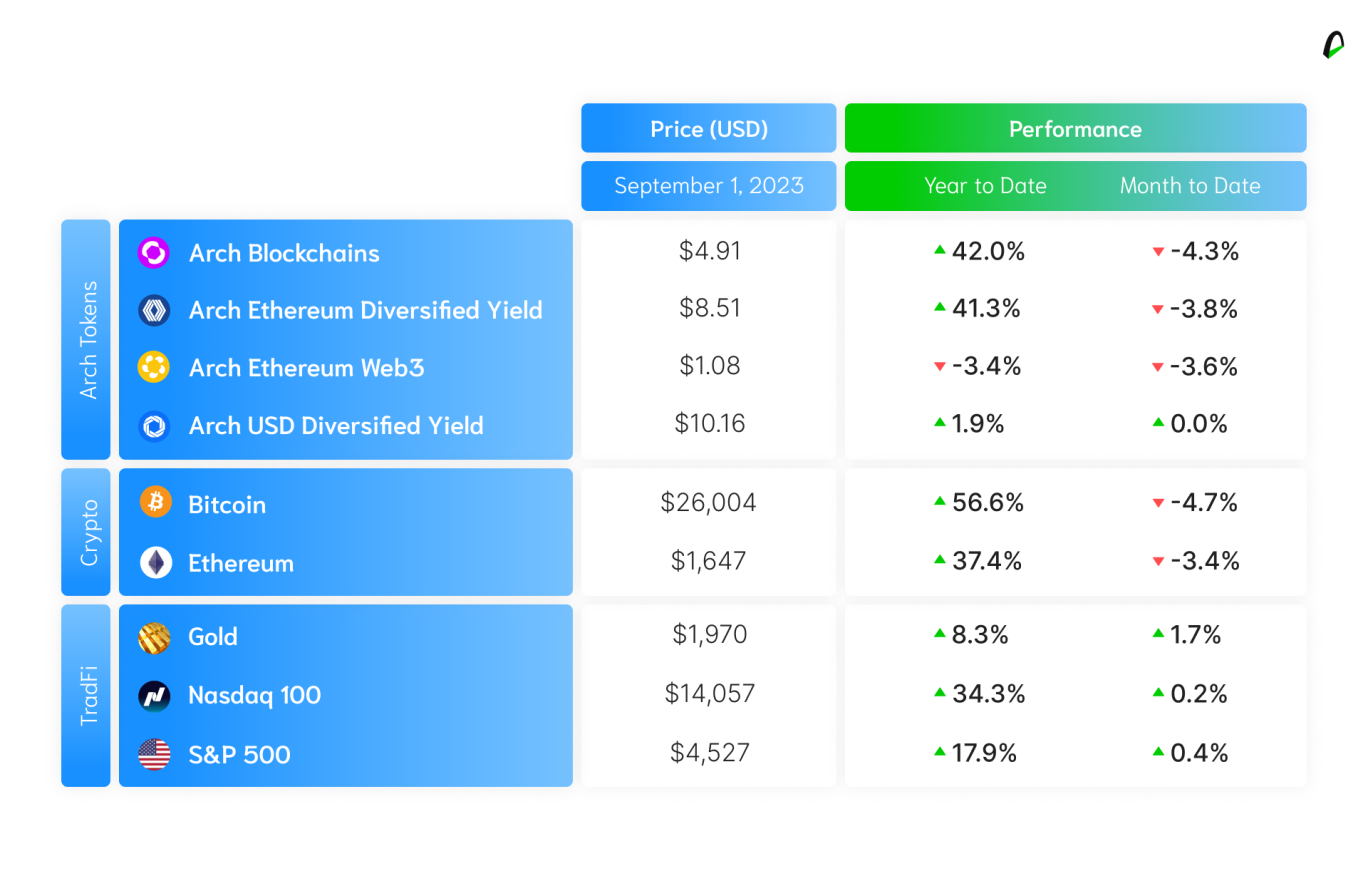Gm fellow Architects;
It's been a nice week on crypto markets. The SEC lost an important battle, we might have a Bitcoin ETF coming up sooner than expected - the chances of one getting approved went up to 75% - and we are seeing more and more adoption inching closer by the minute (looking at you Mercado Pago offering USDC as a payment option).
We bring all the little details you need to talk crypto like a pro.
• The SEC lost a (crypto) battle. Grayscale won, and we might have a Bitcoin ETF coming up.
• Markets reward those that are bold.
• Crypto is having its Legally Blonde moment and crushing it in and out of court.
There's a (potential) bitcoin ETF in the horizon
On August 29th, Grayscale notched a major court win against the US Securities and Exchange Commission (SEC), paving the way for a future spot ETF approval.
Wait. Who is Grayscale again?
Grayscale is one of the largest and oldest asset managers in crypto and the manager of GBTC, the Grayscale Bitcoin Trust.
The GBTC was launched in 2013, initially a private placement, but later converted into a publicly traded vehicle. It's the largest institutional investor in Bitcoin, holding around 3% of all existent bitcoins (roughly $17bn).
Gotcha, and what happened with the SEC?
In 2022, Grayscale applied to transform its non-redeemable Trust into an ETF (an exchange-traded fund). The advantages of such transformation are a few.
The first and main one would be to allow current investors of the Trust to redeem bitcoins directly to their wallets. Plus, other investors could bring their bitcoins from their wallets and generate new units of the ETF.
The possibility of conversion given by a spot ETF creates a portal between the crypto and traditional financial worlds.
Any investor with a brokerage account would theoretically be able to integrate its crypto (bitcoin) with the traditional financial and banking system, making it easier for an average investor (with limited tech-savviness) or an institutional investor (with huge volumes) to get into and out of crypto.
That is what the SEC has been afraid of, and for this reason, it denied the request of Grayscale.
And Grayscale charged back?
Correct. Grayscale appealed the SEC's decision, and the three-judge panel from the US Court of Appeals agreed that the SEC's rejection of the Grayscale proposal was "arbitrary and capricious."
This a bold statement against the regulator and its Belic modus operands concerning crypto-related companies.
According to the Court, the SEC could not explain on a reasonable basis the different treatment given for the approval of futures-based ETF and the Grayscale proposal for a spot ETF.
Although technically distinct, the Court considered both products to be similar in terms of the risks pointed out by the SEC when arguing against the creation of Grayscale's ETF (essentially, price manipulation risks).
Now, explain to me the nitty-gritty of this ETF approval
An additional advantage of the ETF approval for GBTC holders is the price it trades in the market.
Since the Trust is not redeemable, investors have only the secondary market to trade (buy or sell), which makes the price of the Trust differ from its Net Asset Value (i.e., the value of the underlying bitcoins) all the time. Historically, the Trust traded for a premium regarding the Bitcoin price; however, it has been traded at a discount to its fair value in recent years.
At its bottom, the market discount of GBTC reached 48.5%, which is attributed to the SEC's refusal.
When (and if) transformed into a spot ETF, the vehicle should trade very close to its fair value, and the reason is that it will be possible to arbitrate it, mounting and dismounting the ETF unit to sell the underlying separately whenever its price is lower or higher than its implied value.
After recent developments, the GBTC discount narrowed to only 18%, converting this measure as a good indicator of investors' confidence in a spot ETF approval in the US.

So, that means we are having a Bitcoin ETF?
Not really, at least not yet. The sentence does not imply that the spot ETF will be approved. In effect, the Court ruled out that the SEC must review the application.
The logical development is that the Commission must come out with new and sound arguments against the request or (in the absence of those) will have to concede.
The SEC still has 45 days to appeal to the Supreme Court, but doing so would likely trigger a much broader debate about crypto, securities, and regulatory frameworks in the maximum instance of the justice, a scenario that the SEC has strategically avoided so far.
But we may have one in the future, right?
Yes. There are several applications of traditional asset managers for launching a spot ETF in the US. The last and most notable one is the request from BlackRock - the largest money manager in the world, with over $10 trillion of assets.
And is there any other crypto having its own ETF?
Actually, yes. Bitcoin is not the only one being considered. Grayscale, VanEck, Bitwise, Volatility Shares, ProShares, and Round Hill Capital are some of the asset managers that are applying to launch a future-based ETF of Ethereum, the second largest cryptoasset and the most relevant smart-contract platform.
The following developments in the Grayscale case are crucial to understanding the evolution of crypto and its integration into the traditional world as a new and established asset class.
Nice. How can I get exposure to it?
You can get exposure to both Bitcoin and Ethereum with Arch Blockchains. Our product tracks the leading blockchains and comprises 53% Bitcoin and 33% Ethereum, besides Solana and Polygon.
Markets reward the bold (at least in the long term)
The week started with favorable news for crypto investors, as Grayscale secured a victory against the SEC on Tuesday. This propelled Bitcoin's value by 6% to reach $28,000, triggering an $80 million liquidation of short positions in minutes.

The SEC's loss in both the Ripple and the Grayscale cases has given the market optimism that a spot ETF is around the corner.
Still, the hype failed to sustain a more constructive rally, and prices returned to the previous trading level ($26,000 for Bitcoin, $1,600 for Ethereum).
Cryptocurrency's sluggish momentum reflects broader trends in risk assets. Anticipated extended higher US interest rates and a more hawkish Fed communication, driven by core inflation concerns, led to a 1.8% drop in the S&P 500 and a 2.2% drop in the Nasdaq Composite during August.
However, year-to-date, all our portfolios have demonstrated positive performance, with the highest-risk portfolio (the Bold one) being the top performer.
The past two weeks have indeed been challenging for higher-risk assets in general, but it's essential to keep in mind that, over the long term, it can pay off to be bold.
📰 Crypto is crushing it in and out of court
Sure, the SEC has lost two crucial battles this month (one with Ripple and one with Grayscale), but court shenanigans aren't the only thing that's been positive for crypto this week.
⏱ If you only have time for the quick and dirty
- MercadoPago 🤝 crypto. The Latam giant will allow users to buy or sell USDC
- International transfer might soon be done using blockchain
- Bitcoin's average trade size jumped from $850 to $2.000
☕️ If you want the full scoop
🪙 On MercadoPago dabbling into stablecoins: This is the second time we are talking about a payment giant launching something related to stablecoins this month. In our previous newsletter edition, we talked about PayPal launching its own stablecoin. Now, we are talking about MercadoPago allowing users to buy and sell USDC.
With more than 64 million users, as reported in its in-house Impact Report for 2022, MercadoPago is the financial arm of the e-commerce giant Mercado Libre. The latter has earned comparisons to being the "Amazon of Latin America," having generated $10 billion in revenue last year.
They are testing this USDC launch in Chile with plans to roll out in the rest of the region in the coming months.
🌐 On Swift codes getting a Web3 makeover: In a groundbreaking collaboration, the interbank messaging giant Swift and Web3 services platform Chainlink have achieved successful transfers of tokenized value across various private and public blockchains, as revealed in a recent press release.
This accomplishment can potentially eliminate significant obstacles hindering the growth of tokenized asset markets and pave the way for global scalability as these markets continue to mature.
📈 On average, trade size jumping: And hit its highest point since June. This surge followed a federal court ruling that mandated the SEC to reevaluate its rejection of Grayscale Investments' attempt to transform the Grayscale Bitcoin Trust (GBTC) into an ETF on Tuesday.
According to data from Kaiko, the average trade size for Bitcoin on the cryptocurrency exchange surged to over $2,000 on Tuesday after the ruling, up from around $850 the day before. Research firm Kaiko noted that the last time Bitcoin's average trade size exceeded $2,168 was back in June.
🗞 In other news - Powered by The Defiant
- Tether's CTO Explains Why USDT is Still Not Audited
- Elon Musk’s X Obtains License To Enable U.S. Crypto Payments
- IRS Sets Sights On Decentralized Exchanges and NFTs With Proposed Tax Rules
📺 Look mom, we’re on the news!
Talking about crypto markets on Chile's leading financial newspaper

And sharing more about how to invest in crypto and the impact of this technology

Disclaimer: The opinions expressed are for general informational purposes only and are not intended to provide specific advice or recommendations. The views reflected in the commentary are subject to change without notice



